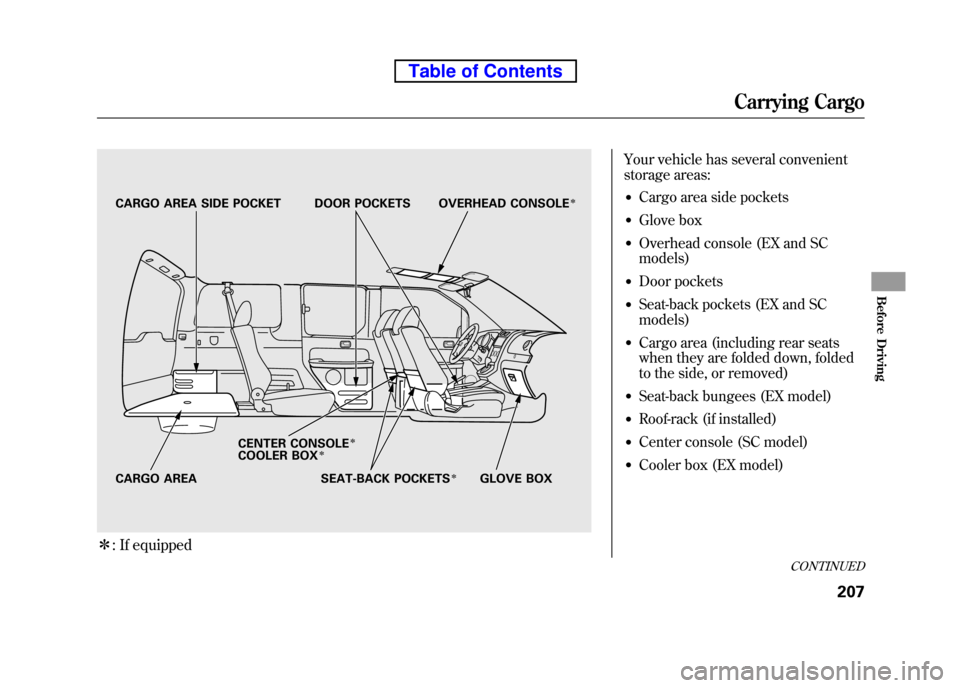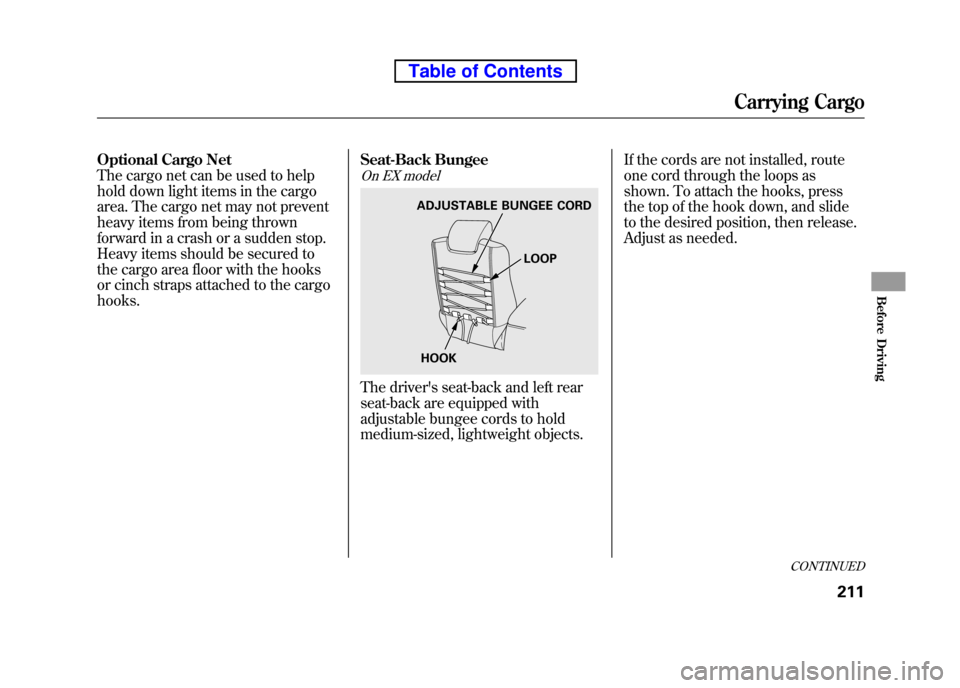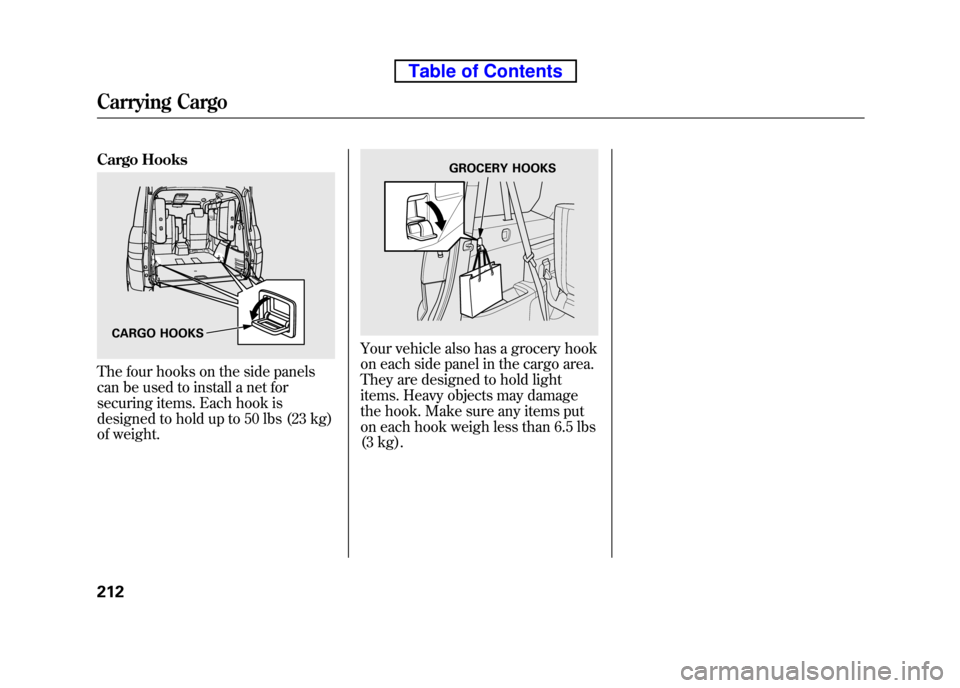HONDA ELEMENT 2010 1.G Owners Manual
Manufacturer: HONDA, Model Year: 2010, Model line: ELEMENT, Model: HONDA ELEMENT 2010 1.GPages: 342, PDF Size: 5.76 MB
Page 221 of 342

Modifying your vehicle, or installing
some non-Honda accessories, can
make it unsafe. Before you make any
modifications or add any accessories,
be sure to read the following information. Accessories
Your dealer has Honda accessories
that allow you to personalize your
vehicle. These accessories have been
designed and approved for your
vehicle, and are covered by warranty.
Although non-Honda accessories
may fit on your vehicle, they may not
meet factory specifications, and could
adversely affect your vehicle's
handling and stability.
Improper accessories or
modifications can affect your
vehicle's handling, stability, and
performance, and cause a
crash in which you can be hurt
or killed.
Follow all instructions in this
owner's manual regarding
accessories and modifications.
When properly installed, cellular
phones, alarms, two-way radios, and
low-powered audio systems should
not interfere with your vehicle's
computer controlled systems, such
as your airbags, anti-lock brakes, and
tire pressure monitoring system. Before installing any accessory:
● Make sure the accessory does not
obscure any lights, or interfere
with proper vehicle operation or performance.
● Be sure electronic accessories do
not overload electrical circuits (see
page 298) or interfere with the
proper operation of your vehicle.
● Before installing any electronic
accessory, have the installer
contact your dealer for assistance.
If possible, have your dealer
inspect the final installation.
● Do not install accessories on the
side pillars or across the rear
windows. Accessories installed in
these areas may interfere with
proper operation of the side
curtain airbags.
CONTINUED
Accessories and Modifications
205
Before Driving
Table of Contents
Page 222 of 342

Modifying Your Vehicle
Removing parts from your vehicle, or
replacing components with some
non-Honda components could
seriously affect your vehicle's
handling, stability, and reliability.
Some examples are:● Lowering the vehicle with a non-
Honda suspension kit that
significantly reduces ground
clearance can allow the
undercarriage to hit speed bumps
or other raised objects, which
could cause the airbags to deploy.
● Raising your vehicle with a non-
Honda suspension kit can affect
the handling and stability. ●
Non-Honda wheels, because they
are a universal design, can cause
excessive stress on suspension
components, and are not
compatible with the tire pressure
monitoring system (TPMS).
● Larger or smaller wheels and tires
can interfere with the operation of
your vehicle's anti-lock brakes and
other systems.
● Modifying your steering wheel or
any other part of your vehicle's
safety features can make the
systems ineffective.
If you plan to modify your vehicle,
consult your dealer.
Accessories and Modifications
206
Table of Contents
Page 223 of 342

ꭧ: If equipped Your vehicle has several convenient
storage areas:
● Cargo area side pockets
● Glove box
● Overhead console (EX and SCmodels)
● Door pockets
● Seat-back pockets (EX and SCmodels)
● Cargo area (including rear seats
when they are folded down, folded
to the side, or removed)
● Seat-back bungees (EX model)
● Roof-rack (if installed)
● Center console (SC model)
● Cooler box (EX model)
CARGO AREA CENTER CONSOLE
ꭧ
COOLER BOXꭧ
SEAT-BACK POCKETSꭧGLOVE BOX
CARGO AREA SIDE POCKET DOOR POCKETS OVERHEAD CONSOLE
ꭧ
CONTINUED
Carrying Cargo
207
Before Driving
Table of Contents
Page 224 of 342

However, carrying too much cargo, or
improperly storing it, can affect your
vehicle's handling, stability, stopping
distance, tires, and make it unsafe.
Before carrying any type of cargo, be
sure to read the following pages.
Load Limits
The maximum load for your vehicle
is 670 lbs (305 kg).
See Tire And Loading Information
label attached to the driver'sdoorjamb.Label Example
This figure includes the total weight
of all occupants, cargo, and
accessories, and the tongue load if
you are towing a trailer.
Overloading or improper
loading can affect handling and
stability and cause a crash in
which you can be hurt or killed.
Follow all load limits and other
loading guidelines in thismanual.Steps for Determining Correct LoadLimit
-
1. Locate the statement ‘‘The
combined weight of occupants and
cargo should never exceed XXX kg
or XXX lbs. ’’on your vehicle's
placard.
2. Determine the combined weight of the driver and passengers that will
be riding in your vehicle.
3. Subtract the combined weight of the driver and passengers from
XXX kg or XXX lbs.
Carrying Cargo
208
Table of Contents
Page 225 of 342

4. The resulting figure equals theavailable amount of cargo and
luggage load capacity. For
example, if the ‘‘XXX ’’amount
equals 1,400 lbs. and there will be
five 150 lb. passengers in your
vehicle, the amount of available
cargo and luggage load capacity is
650 lbs. (1,400 -750 (5 ╳150) =650 lbs.)
5. Determine the combined weight of luggage and cargo being loaded on
the vehicle. That weight may not
safely exceed the available cargo
and luggage load capacity
calculated in Step 4.
6. If your vehicle will be towing a trailer, load from your trailer will be
transferred to your vehicle. Consult
this manual to determine how this
reduces the available cargo and
luggage load capacity of yourvehicle. Example 1
Example 2
Example 3
In addition, the total weight of the vehicle, all occupants, accessories, cargo,
and trailer tongue load must not exceed the Gross Vehicle Weight Rating
(GVWR) or the Gross Axle Weight Rating (GAWR). Both are on a label on the
driver's doorjamb.
Max Load (675 lbs) Passenger Weight (150 lbs x 2 = 300 lbs) Cargo Weight
(375 lbs)
Max Load (675 lbs) Passenger Weight
(150 lbs x 3 = 450 lbs) Cargo Weight
(225 lbs)
Max Load (675 lbs) Passenger Weight
(150 lbs x 4 = 600 lbs) Cargo Weight
(75 lbs)
CONTINUED
Carrying Cargo
209
Before Driving
Table of Contents
Page 226 of 342

Carrying Items in the Passenger Compartment● Store or secure all items that could
be thrown around and hurt
someone during a crash.
● Be sure items placed on the floor
behind the front seats cannot roll
under the seats and interfere with
the pedals, the seat operation, or
the proper operation of the sensors
under the seats.
● Keep the glove box closed while
driving. If it is open, a passenger
could injure their knees during a
crash or sudden stop. ●
If you fold the rear seats down or
up, or remove them, tie down
items that could be thrown about
the vehicle during a crash or
sudden stop. Also, keep all cargo
below the bottom of the windows.
If it is higher, it could interfere
with the proper operation of the
side curtain airbags.
Carrying Cargo in the Cargo Area
or on a Roof Rack ● Distribute cargo evenly on the
floor of the cargo area, placing the
heaviest items on the bottom and
as far forward as possible. Tie
down items that could be thrown
about the vehicle during a crash or
sudden stop. ●
If you carry large items that
prevent you from closing the
tailgate or the hatch, exhaust gas
can enter the passenger area. To
avoid the possibility of carbon
monoxide poisoning, follow the
instructions on page 52.
● If you carry any items on a roof
rack, be sure the total weight of
the rack and the items does not
exceed 75 lbs (34 kg).
If you use an accessory roof rack,
the roof rack weight limit may be
lower. Refer to the information that
came with your roof rack.
Carrying Cargo
210
Table of Contents
Page 227 of 342

Optional Cargo Net
The cargo net can be used to help
hold down light items in the cargo
area. The cargo net may not prevent
heavy items from being thrown
forward in a crash or a sudden stop.
Heavy items should be secured to
the cargo area floor with the hooks
or cinch straps attached to the cargohooks.Seat-Back Bungee
On EX model
The driver's seat-back and left rear
seat-back are equipped with
adjustable bungee cords to hold
medium-sized, lightweight objects.If the cords are not installed, route
one cord through the loops as
shown. To attach the hooks, press
the top of the hook down, and slide
to the desired position, then release.
Adjust as needed.
ADJUSTABLE BUNGEE CORD
LOOP
HOOK
CONTINUED
Carrying Cargo
211
Before Driving
Table of Contents
Page 228 of 342

Cargo Hooks
The four hooks on the side panels
can be used to install a net for
securing items. Each hook is
designed to hold up to 50 lbs (23 kg)
of weight.
Your vehicle also has a grocery hook
on each side panel in the cargo area.
They are designed to hold light
items. Heavy objects may damage
the hook. Make sure any items put
on each hook weigh less than 6.5 lbs
(3 kg).
CARGO HOOKS
GROCERY HOOKS
Carrying Cargo
212
Table of Contents
Page 229 of 342

This section gives you tips on
starting the engine under various
conditions, and how to operate the
manual and automatic transmissions.
It also includes important information
on parking your vehicle, the braking
system, the vehicle stability assist(VSA
®) system, the tire pressure
monitoring system (TPMS), and
facts you need if you are planning to
tow a trailer or drive off-highway.
Driving Guidelines ......................
214
Preparing to Drive ......................
215
Starting the Engine .....................216
Manual Transmission .................
217
Automatic Transmission .............219
Parking .......................................
223
Braking System .......................... 224
Anti-lock Brakes (ABS) ...............225
Tire Pressure Monitoring System
(TPMS) ................................... 227
Vehicle Stability Assist (VSA
®),
aka Electronic Stability Control (ESC), System .....................230
Towing a Trailer .......................... 232
Off-Highway Driving
Guidelines ............................... 238
Driving
213
Driving
Page 230 of 342

Your vehicle has a higher ground
clearance that allows you to travel
over bumps, obstacles, and rough
terrain. It also provides good
visibility so you can anticipate
problems earlier.
Because your vehicle rides higher off
the ground, it has a high center of
gravity that can cause it to roll over if
you make abrupt turns. Utility
vehicles have a significantly higher
roll over rate than other types of vehicles.
To prevent rollovers or loss of control:● Take corners at slower speeds
than you would with a passengervehicle.
● Avoid sharp turns and abrupt
maneuvers whenever possible. ●
Do not modify your vehicle in any
way that would raise the center ofgravity.
● Do not carry heavy cargo on theroof.Four-wheel drive models
Your vehicle is equipped with a four-
wheel drive (4WD) system. When
the system senses a loss of front-
wheel traction, it automatically
transfers some power to the rear
wheels. This gives you better traction
and mobility.
You still need to exercise the same
care when accelerating, steering, and
braking that you would in a two-
wheel drive vehicle.
See page 238 for off-highway driving
guidelines.
Driving Guidelines
214
Table of Contents